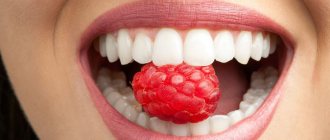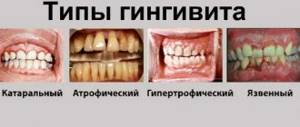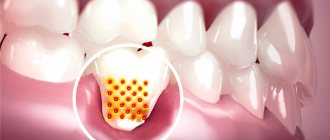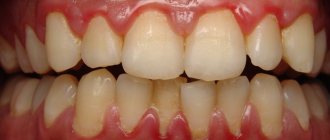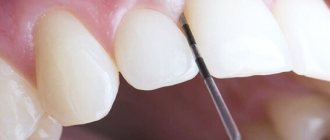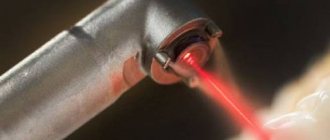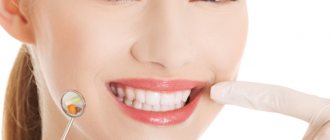The use of laser in dentistry helps to cope with such serious gum diseases as periodontitis and periodontal disease. The danger of these diseases is that, developing gradually, they cause significant harm, usually by the age of 45–55. It all starts with bleeding gums, then loosening of the teeth, and then the tooth no longer holds in the jaw and falls out. Thus, in a short time a person loses, if not all his teeth, then a significant part of them. This can be avoided by promptly seeking treatment from a periodontist.
The main focus of the treatment of periodontitis and periodontal disease is the fight against infection located in the gum pockets. In a healthy state, there is no pocket between the gum and tooth. The gum is dense, elastic, and fits well to the tooth. With periodontitis, the gum becomes inflamed, moves away from the tooth and a periodontal pocket forms, in which plaque teeming with bacteria accumulates. Treatment of periodontitis begins with cleaning out the periodontal pocket so that the gum adheres to the tooth as much as possible, but this is not easy to do, since the pockets are complex in shape and deep. If the periodontal pocket is not completely cleaned, then with a decrease in immunity and certain endocrine conditions, a recurrence of periodontitis may occur.
Operating principle
A laser is a quantum generator capable of creating a continuous or pulsed stream of light in various spectral ranges, in particular ultraviolet and infrared. Electromagnetic waves emitted by a laser beam have thermal, photochemical, mechanical and energy properties, which opens up wide opportunities for a whole range of dental procedures, including the treatment of diseases of the soft tissues of the oral cavity. There are several types of medical lasers: each of them has its own technical parameters and purpose. Erbium laser is used to work with hard tissues, carbon dioxide is used for surgical procedures, and diode is intended for therapeutic procedures.
Laser treatment of gums and teeth is possible in most cases. Laser technologies are equally successful in therapeutic and surgical procedures.
Indications
- Removal of tartar as part of the prevention and treatment of periodontal diseases.
- Treatment of gingivitis. The diode laser helps relieve inflammation, remove plaque, stop bleeding and reduce trauma during surgery. Ideal for removing fibrous tissue in hypertrophic gingivitis.
- Treatment of periodontitis. In advanced forms of periodontitis, laser curettage is performed to remove pus, plaque and granulation tissue in periodontal pockets. Laser is also effective as an adjunctive anti-inflammatory therapy.
- Loss of soft tissue. Laser treatment of gum recession allows for surgical intervention with minimal damage to soft tissue.
- Treatment of complications associated with pulpitis and periodontitis. Using a laser, granulomas, fistulas, abscesses, and so on are treated and removed.
On the Internet you can find many materials that talk about the treatment of gum periodontal disease with a laser. Periodontal disease is not an inflammatory disease and is not accompanied by purulent discharge or bleeding. When it comes to laser curettage, it refers to periodontitis (some sources and specialists combine these diseases).
LASER WHITENING.
Shiny white teeth are an indispensable symbol of prosperity, success, and health. A pleasant smile creates a favorable impression on the interlocutor and helps to establish contact, which is especially important during business negotiations, according to the ethics of modern business.
The laser teeth whitening procedure is performed using a specially designed gel with whitening properties. The laser light affects the composition of the gel, after which it begins to join the process and perform its function. It takes half a minute for each tooth, after which you should leave the gel for 15-20 minutes. Following from the above, we can safely say that laser whitening is a painless, highly effective procedure, which, moreover, takes a minimum of time. After the procedure is completed, there is no need to worry about the appearance of hypersensitivity of the teeth, since the gel, together with the laser light, is gentle on the enamel, and the tissues are not overheated. Thanks to laser whitening, it is possible to lighten tooth enamel by 5-6 tones, as well as eliminate discoloration
.
Read more about laser teeth whitening
Discoloration
- a change in the color of teeth, which is called discoloration, can occur for various reasons. They can be caused both by external influences on the surface of the teeth and by internal problems of the body itself.
External factors include drinking coffee, strong tea, red wine, and certain types of fruits and vegetables. Smoking has an extremely negative effect on the color of teeth. Heavy smokers tend to have yellow teeth. Lack of hygiene skills, expressed in not regularly brushing your teeth, contributes to the appearance of plaque on the surface of the teeth.
Some medications, when taken orally, can also stain teeth. This is especially true for taking tetracycline. In children, such changes can be a manifestation of an infection that they received before birth, as well as incompatibility of the blood type with the mother. Color may change due to injury or treatment. Internal causes of tooth discoloration are mostly of genetic origin, so some people have lighter tooth enamel, while others have darker tooth enamel. Another factor that leads to discoloration of tooth enamel is an insufficient amount of saliva caused by certain diseases.
What are the advantages: 1. The duration of the session (15-30 minutes) is much shorter. 2. The effect is most pronounced. 3. The laser has bactericidal properties, prevents the development of caries and gum disease. 4. Cleanses tooth enamel from various pigment formations.
Contraindications to treatment
Like any technology, laser has contraindications that prevent its use in a number of cases, including:
- oncological diseases (especially malignant tumors in the oral cavity, head and neck area);
- tuberculosis;
- severe forms of diabetes mellitus;
- cardiovascular diseases;
- bleeding disorders, a number of autoimmune diseases.
If contraindications are suspected, the doctor may refer the patient to undergo additional diagnostic procedures.
Our specialists
- Gogia Tea Zurabovna
Dentist-therapiston Komsomolskaya
- Bystrikova (Murashkina) Valeria Pavlovna
Dentist-therapist
on Mayakovsky
- Gracheva Natalia Alexandrovna
Dentist-therapist
on Komsomolskaya
- Yarygina Larisa Borisovna
Dentist-therapist
on Kalanchevskaya
Method of treatment
Laser treatment of gums takes place in several stages. The nuances depend on the specific procedure and the number of manipulations required. Before using the laser, the patient wears special safety glasses.
- Diagnostics. Identification of contraindications to the use of laser. A panoramic photograph of the jaw, a blood test, taking smears from the mucous membrane, microbiological studies and other diagnostic procedures related to the inflammatory process in periodontal tissues.
- Professional cleaning and sanitation of the oral cavity.
- Conducting anesthesia (if necessary).
- When using a laser therapeutically, in particular when cleaning periodontal pockets, a marking photosensitizer gel is first applied, which highlights areas of plaque and dental plaque accumulation. During surgical procedures, additional protection of surrounding tissues is required.
Causes of periodontal disease development
The appearance of periodontal disease occurs for various reasons. As a result of examining more than 750 thousand patients, US scientists found that the disease primarily develops due to bacterial plaque on the teeth and a decrease in the body’s immune defense. It has been established that microorganisms that live in deposits and plaque on teeth are directly related to the development of the disease. It is the waste products of these microbes that have a negative effect on the gums and dental tissue, causing their destruction.
First, a person notices bleeding gums while brushing their teeth, which can also be accompanied by pain. Therefore, the process of oral and dental hygiene becomes more careful and of lower quality. As a result, plaque only increases, turning into tartar. At the same time, the environment for the development of microorganisms becomes especially beneficial.
During this time, inflammation and periodontal condition only worsens. Moreover, the negative process affects the activity of microvessels, which reduces nutrition, accelerating destruction. After this, the inflammatory phenomenon affects the bone tissue.
Another reason for the development of periodontal disease lies in the disruption of immune defense. The human body can be subject to disruptions due to stressful situations, trauma, and hormonal problems. As a result, immune cells perceive periodontal tissues as foreign and attack them. Such exposure causes aseptic inflammation of the gum tissue with subsequent death. Then the negative process moves to the bone tissue. The third stage of the disease is characterized by loosening and loss of teeth.
The following factors can aggravate the course of the disease: diabetes, smoking, gastrointestinal disorders, stress, hormonal imbalances, advanced caries, poor dentures and malocclusion.
Advantages and disadvantages
- Laser treatment of gums allows you to quickly cope with pathogenic bacteria. When the laser comes into contact with the mucosal surface, a photocoagulation film is formed, which prevents infection and re-inflammation.
- The beam operates with high precision even on a minimal working area, which allows you to preserve the maximum volume of healthy tissue.
- No bleeding or serious damage during surgical procedures.
- The use of laser accelerates the process of tissue regeneration.
- Possibility of treating children and pregnant women.
- Quite a large number of restrictions.
- High cost of treatment.
GUM REJUVENATION (STRENGTHENING) BY FRACTIONAL PHOTOTHERMOLYSIS (LPM – TECHNOLOGY).
LPM method (gum rejuvenation)
— elimination of multiple gum recessions surgically using a flap from the palatal surface.
LPM technology is based on the effect of minimal thermal laser exposure on the surface of the gum mucosa. Coagulation microcolumns are created on the cervical and attached gums. The creation of this kind of microzones initiates a complex of processes, as a result of which the regeneration of periodontal tissues and restoration of the dental-gingival attachment occurs in patients with early and middle stage periodontal diseases. LPM technology can also be used for aesthetic purposes (eg, removal of gingival hyperpigmentation).
Thanks to the natural healing process, stimulating the blood supply to the gingival margin, periodontal ligament and alveolar bone, the structure of the tissues exposed to the laser is restored within 1 month.
Features of laser periodontitis treatment
Moderate and severe severity of periodontitis (inflammation of the periodontal tissue) is characterized by the formation of gum “pockets” with purulent contents. They represent a source of constant infection in the body, which must be sanitized as quickly as possible. If previously success could only be achieved through surgery, today dentists are increasingly resorting to bloodless laser treatment. What is it? First, the doctor will conduct a full examination to exclude the patient from having absolute contraindications for laser treatment (chronic endocrine diseases, a history of heart attack, oral oncology). Then, depending on the clinical picture and technical equipment of the dental clinic, the type of laser for the procedure will be selected: diode, neodymium, holmium or erbium. After this, in compliance with all conditions of dental sterility, a laser light guide is inserted into the periodontal cavity. Under the influence of the energy of the laser beam, tissues affected by bacteria “evaporate”, while neighboring healthy ones remain uninjured.
Frenulotomy/ectomy (excision of frenulum)
Frenulotomy (frenectomy)
– plastic surgery of the frenulum.
For a patient with a wide frenulum, the interdental papilla and tissue in the bone space are excised.
Bridle
- this is a small strip or fold of mucous membrane that connects the lips and cheeks to the alveolar process and limits their mobility. A pathological frenulum can initiate periodontal disease by retracting healthy marginal gums, so it must be removed.
Possible consequences of having a pathological frenulum:
- Gum recession.
- Diastema formation.
- Accumulation of plaque as a result of retraction of the marginal gum and opening of the groove.
It is necessary to remove a thick and wide frenulum, as it can interfere with the use of a toothbrush and, therefore, will contribute to the development of inflammation and periodontitis. Excision of the frenulum must be performed before orthodontic treatment.
Frenulotomy
- This is a simple dissection of the frenulum from the apex of the attachment to the base down to the alveolar process.
Frenulectomy
- This is a complete excision of the frenulum, including attachment to the underlying alveolar process.
Benefits of laser periodontitis treatment
No pain.
The bloodlessness of the operation, which was mentioned earlier, also implies absolute painlessness. The patient will not feel any discomfort or the need for anesthesia.
Save time.
Treatment of “pockets” with a laser will last no more than 1.5–2 hours. The problem can be solved in one visit to the dentist.
Fast rehabilitation.
Within a day, the patient will be able to resume their usual lifestyle, since after laser intervention there is no bleeding or food restrictions.
Aesthetic component.
An additional bonus of the procedure is polishing the roots of the teeth and whitening the crown part.
Efficiency guaranteed.
After laser treatment, sterility is maintained in the periodontal cavity, due to which periodontal destruction stops.
VESTIBULOPLASTY
Vestibuloplasty
is an operation that allows you to correct the depth of the vestibule of the oral cavity. By eliminating defects in soft tissue attachment, you can improve the aesthetics of your smile, bite, and dental and periodontal health.
Vestibuloplasty is a type of oral correction performed in the space between the lip and teeth. Dentists prescribe this operation when the vestibule of the patient’s mouth is too small. The need for correction is due to the fact that this situation can cause the development of a number of dental problems.
The main indications for mandatory intervention are the following situations:
- the patient has been diagnosed with periodontal disease, in particular periodontal disease or its complication in the form of periodontitis;
- preparation for prosthetics to ensure high-quality fixation of the prosthesis;
- implantation of an implant, especially with a very high attachment of the muscle to the alveolar process;
- treatment by an orthodontist due to, for example, malocclusion;
- according to the testimony of a speech therapist;
- in order to prevent gum recession.
This procedure helps:
- reducing gum tension;
- deepening of the vestibule of the mouth;
- expansion of the area of the attached gum;
- prevention of speech therapy, orthodontic and dental diseases.
Instead of a surgical scalpel, the doctor uses a laser beam. This is the least traumatic intervention option of all existing ones.
It has the following advantages:
- the ability to effectively expand the vestibule of the mouth;
- possibility of increasing the area of fixed gums;
- absence of edema (or they are completely insignificant);
- high precision of all manipulations (cuts, etc.);
- no bleeding;
- reducing the risk of infection;
- maintaining aesthetics.
The recovery period after the intervention takes much less time than with classical techniques.
How much does laser gum treatment cost?
The cost of laser treatment directly depends on the procedure, as well as on the level of the clinic and the qualifications of the doctor. Professional teeth cleaning with a laser in Moscow costs from 180 – 200 rubles per tooth. Treatment of gums using a diode laser (photodynamic laser therapy) will cost an average of 6,000 rubles per jaw. Laser curettage is an even more expensive procedure: you will have to pay a thousand or more rubles to treat one periodontal pocket. Surgical procedures using lasers also cannot be called cheap. For example, a patchwork operation on a small fragment of gum will cost 5,000 – 6,000 rubles. Despite the fact that the cost of laser treatment is high, the advantages of this technique make it increasingly in demand. Read about other gum treatment methods in the article.
Detailed cost
| Service | Price |
| Laser therapy (1 jaw) | RUB 1,360 |
| Treatment of gingivitis with medication (in the area of 1 tooth) | 700 rub. |
| Treatment of gingivitis with medication (in the region of a fragment of 3-4 teeth) | 1,900 rub. |
| Treatment with the “Vector” device (for 1 tooth) | 450 rub. |
| Generalized treatment of gingivitis | RUB 2,990 |
| Periodontal dressing "Septopak" | 530 rub. |
| Periodontal bandage "Barricade" | 840 rub. |
| Taking an autograft bone | 17,000 rub. |
| Sinus lift operation (soft) | 14,000 rub. |
| Sinus lift surgery (classic) | RUB 37,500 |
| Sinus lift surgery (complicated) | RUB 46,800 |
MAKE AN APPOINTMENT
Periodontal disease - how is it diagnosed?
Correct treatment of periodontal disease is possible only after a thorough diagnosis. However, one examination by a dentist will not be enough. You should undergo tests using modern equipment and drugs.
In the dental practice of the Bionic Dentis clinic, the German protocol is used to examine patients. This allows you to conduct a full examination and accurately make a diagnosis.
This examination includes:
- Inspection using an optical system that allows you to significantly enlarge the inspected surface and not miss even the slightest damage;
- Testing for hidden plaque on teeth. To do this, a special preparation is applied, which indicates the places where harmful microbes accumulate;
- Determination of inflammation using a marker drug that can indicate lesions;
- Bana testing, which helps identify microorganisms that cause the development of the disease. Thanks to this technique, a competent selection of antibacterial therapy occurs. Specialists from the Bionic Dentis clinic were among the first to conduct bana testing in Russia;
- An X-ray and orthopantomographic examination procedure that allows you to assess the condition of all dental tissues that are not visible during a simple examination. This helps prevent and prevent further development of inflammation.
After reviewing the results of a complete diagnosis of the patient, specialists at the Bionic Dentis clinic draw up a treatment plan. This approach allows us to completely cure 99% of patients suffering from periodontal disease who contact us.

